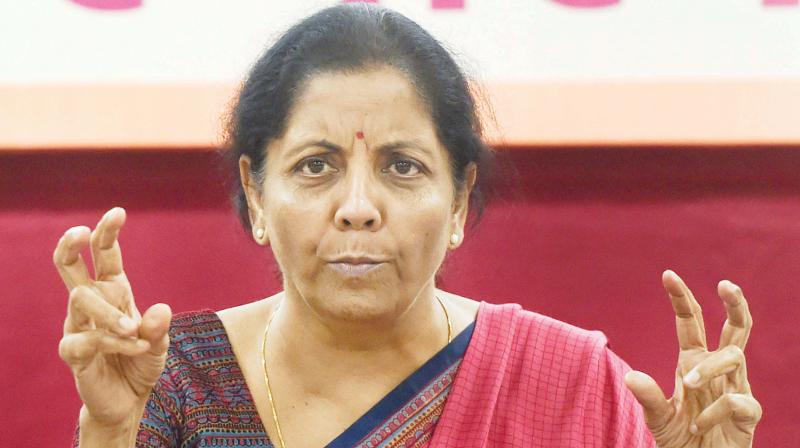
GDP never fell: Why Nirmala Sitharaman is right about demonetization

Finance Minister Nirmala Sitharaman is right about demonetization. In fact, she is always right. As defence minister she was right about the Rafale deal, which, she said could be held up as an epitome of transparency, honesty, and anti-cronyism. As commerce minister she was right about, er, well about everything she said and even about what she left unsaid.
Being right is a perk of politics and power. Even if facts point in a different directions, being right is a fundamental right of politics. So, she is right with her hypothesis — cross that, actually verdict — that demonetization didn’t have any effect on the Indian economy.
No, of course, the Indian GDP didn’t take a hit. People did not lose their jobs. The savings didn’t crash. A day after demonetization, Prime Minister exulted in Japan with a Cheshire Cat smile: There is a wedding at home, but there is no money. Cue in, laughter from the NRI audience.
All that, perhaps, happened in some parallel universe. But, we will come to that later. First, let’s see how demonetization actually did not have any effect, even of the variety the government did not have in mind.
That fateful night, November 8, 2016, in case some of you forgot, Prime Minister Narendra Modi banned ₹500 and ₹1000 currency notes with three primary objectives in mind. One, the decision will wipe black currency — unaccounted wealth, basically — from the system. Two, it would break the back of terrorism by choking the supply of money to terror groups.
And three, it will end corruption. Later, as the narrative didn’t support the promised hypothesis, the objectives were changed almost every day: cashless India, more digital transactions, more money in banks, and, finally, a call for queuing up, it’s an exercise in the nation building.
Bang on! NO IMPACT.
The government’s hopes that at least 30 per cent of the black money would not return to the banking system was dashed within a few days. Out of the nearly 17,500 lakh crore in circulation, nearly 99.7% was deposited in banks. With a wave of his wand, Modi managed to legitimize several generations of black money.
In the fresh spring of demonetization, the government’s hopes were in full bloom, like the tulips in Kashmir’s. The government believed that around ₹3-4 lakh crores of this currency would never return to banks. Scared of a blowback, people would throw this money, as Modi said with glee and optimism, into the Ganges. Alas, the hope wilted like the Tulips that are lent to us briefly.
Also read: Taxpayers hope high on sops in Union Budget 2019
Two years later, the cash in circulation has risen to nearly 21 lakh crore, implying cash is again the king, both black and white. And the banks are ruing their luck for having to pay more interest on the money that was parked in their strong rooms without a commensurate boom in borrowings.
Terror, the second on the demonetization Bucket List, actually picked up. An attack on Uri was followed by mayhem in Pulwama. These big bang incidents coincided through a spurt in encounters and attacks in Kashmir, in Naxal areas.
Cashless India? Yes, debit card transactions doubled after demonetization, credit card usage sped up by 2018. But, it was nowhere close to the 105% bump that followed demonetization, a rise that can now be safely attributed to the TINA factor — no money in ATM, so there is no alternative.
Corruption? Since there is no Sensex to measure the extent of this menace, the only indicator is India’s current position on the global corruption index — 78, just three notches higher than 2017. Is it really gone from our lives, made extinct like dinosaurs by Modi’s surgical strike? Well, suffice to say, we are like this only.
Also read: India’s economy in deep crisis, all eyes on Sitharaman before budget
What, instead changed in a universe that Sitharaman obviously doesn’t dwell in is what former Prime Minister Manmohan Singh had pointed out: The GDP fell by nearly two percent.
Six months after Modi outlawed those notes, the GDP fell to 6.1 per cent. (And we are not even talking about Arvind Subramanian’s claim that this figure too might have been at least 2 per cent higher than the actual number.) A study by Harvard University noted the cross-sectional responses to demonetization “cumulate to a contraction in employment and nightlights-based output due to demonetization of 2 percentage points and of bank credit of 2 percentage points in 2016-Q4 relative to their counterfactual paths.”
In the first quarter of 2019, the GDP advanced by a mere 5.8 per cent, down from 6.6 per cent year on year. Many experts believe now we are not even a 4% economy. Several of our key sectors are showing signs of stress. How much of this is because of the demonetization jolt is yet to be assessed.
Also, India has seen historic laws in unemployment figures — its rate doubled in two years since April 2017, peaking at 7.6%, the highest in 45 years. But, Sitharaman, like the privileged Boss, is right. Nothing changed.
Oh, actually, demonetization never happened. It was just a nightmare from some alternate universe that even the PM seems to have forgotten.


